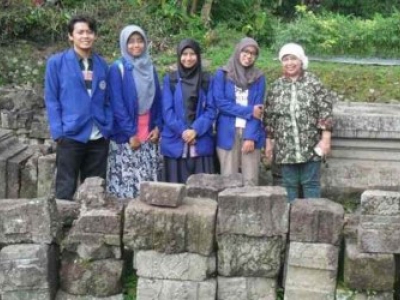TRACING THE REMAINS OF SYAILENDRA DYNASTY IN THE TEMANGGUNG REGENCY

The team of Student Creativity Program (SCP) YSU is researching the remains of Syailendra dynasty in Temanggung regency, Central Java. The location examined by the students including; Tlahab Tourism Village, Canggal, Kruwisan, Paponan, and Petarangan known as Dewata Cengkar region. The SCP Team, consisting of Hanifah Nurunnikmah (Indonesian Language Education and Literature -FLA), Nurullia Fitri Chandrawati (Indonesian Language Education and Literature -FLA), Rati Ayu Pratiwi (Javanese Language Education-FLA), Tejo Mukti Wibowo (Javanese Language Education-FLA) and Fatima Dayaning Pertiwi (History Education-FSS) had examined the site that has been inspired by the development of the Syailendra Park’s master plan in the area.
Driven by curiosity for truth of the belief that the local communities of Dewata Cengkar was the Syailendra dynasty’s territory, the SCP team ,funded by the Indonesian Directorate General of Higher Education in 2016 under the guidance of Dr. Kun Setyaning Astuti, did a research on tracing the remains Syailendra dynasty in the district of Temanggung and Wonosobo on the premise that the two regions have the same culture, and it is possible that the boundaries during the Syailendra dynasty is different from the boundaries of the moment, thus the district of Temanggung and Wonosobo in the past used to be one.
According to the supervising lecturer of SCP, Dr. Kun Setyaning Astuti, the research approach used was qualitative ethnographic method. "The data collection technique used observation, interview, literature and technical documentation" she said. Observations made on the ancient relics that are often found in the area, such in Watu Ambal, in the form of staircase 99, Lingga and Yoni, Gondosuli Inscription, Nandhi statue in the temple ruins near Gondo Suli inscription, Pring Apus temple, and also the newly discovered temple in the area of Liyangan that is estimated to be 24 hectares and is older than the Borobudur Temple.
For now, the research results show that the Kledung district community is a descendant of Syailendra. This was demonstrated by their traditional art that symbolizes the development of the Syailendra dynasty, the indigenous Kledung cultural communities that symbolize Syailendra’s culture, and the legend that developed in the community for generations. "Also, there are objects in the communities that are considered sacred like Necklace of Budho and Ondho Budho" Dr. Kun Setyaning Astuti stated. However, based on the ancient relics that were found in the area indicate that the Sanjaya dynasty has a greater influence. This is demonstrated by the discovery of the lingga and yoni, Nandhi statue, and the statue of Ganesha, Shiva statue and others important relics in the area.
Hanifah Nurunnikmah said that the mixing of the Sailendra and Sanjaya dynasty relics shows that before the 9th century there has been a very harmonious tolerance between Buddhist Syailendra and Hindu Sanjaya. "This is shown in Gondosuli inscription and the stone ruins of the temple near the inscription that show the tolerance between Hindus and Buddhists" said Hanifah. The inscription dated 754 AD indicates that the building was built before the historical marriage of Rakai Pikatan from Sanjaya Dynasty and Pramodya Wardani Sanjaya from Syailendra dynasty in the 9th century. Recommendation from this study is the naming of “Syailendra Parks “ in the Dewata Cengkar region, Temanggung, more accurately, should be called " Sanjaya Garden ", given the discovery of Sanjaya Dynasty relics to be more prevalent than the Syailendra Dynasty’s, . Thus, the naming of "Syailendra Park" needs to be revised.
According to Tejo Mukti Wibowo, there are lots of other interesting things obtained in this study, including the discovery of around 100 jars of Tang Dynasty around the 9th century and jars of local produce in the newly discovered temple site, which is in Liyangan. "This shows that the local population is a society that has an advantage in diplomacy and able to establish international cooperation relations, especially with the Chinese since the ancient Mataram era" he said "In addition, we also found charcoal dating from the 2nd century". If it is true then the civilization around Liyangan is a civilization older than the oldest kingdom in Indonesia, which is the Kutai kingdom. At the location of the temple, they also discovered grain and hay stored in the box. Grain and straw are still intact, but the color is already black. (Kun S.A)

